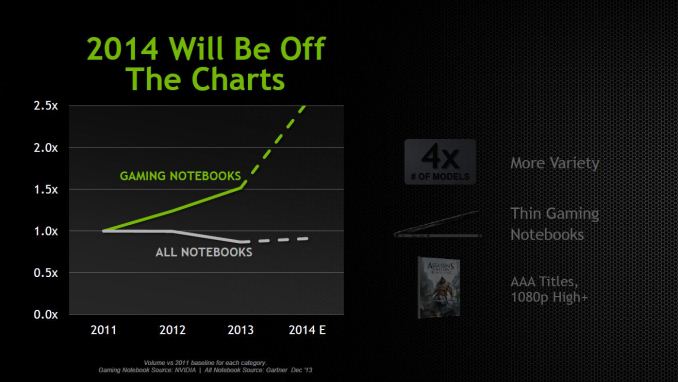NVIDIA’s GeForce 800M Lineup for Laptops and Battery Boost
by Jarred Walton on March 12, 2014 12:00 PM ESTClosing Thoughts
Overall, NVIDIA’s mobile GPU solutions continue to be the de facto standard bearer for gaming laptops. AMD’s upcoming Kaveri APUs will almost certainly do well in the budget sector, but users that want more performance – from both the CPU as well as the GPU – will likely continue to go with NVIDIA Optimus solutions, and if you’re the type of gamer that wants to be able to run at least 1080p with high quality settings, you’ll need at least a GTX class GPU to get there. The good news is that you should have plenty of choices in the coming months, and not only are we seeing faster GPUs but many laptops are starting to come out with high quality 3K and 4K displays.
Speaking of which, I also want to note that anyone that thinks “gaming laptops” are a joke either needs to temper their requirements or else give some of the latest offerings a shot. While it’s not possible to simply run all games at 1080p (or QHD+) with maxed out settings without a beefy GPU, even the GT 750M GDDR5 is able to deliver a good gaming experience for most titles at 900p High/1080p Medium settings. The GTX 850M should be quite a bit faster (~60%) than the GT 750M, and we should see it in notebooks that may cost as little as $1000. It’s no surprise then that NVIDIA thinks 2014 gaming notebook sales will be “off the charts”.
As is often the case, we haven’t been sampled any notebooks prior to the launch of the latest 800M series, but we should get some in the near future. We’re looking forward to Maxwell parts in particular, though for now it appears we’ll have to wait a bit for the high-end Maxwell SKUs to arrive (just like on the desktop). It will also be interesting to see how the GTX 860M Kepler and Maxwell variants compare in terms of performance, power, and battery life; I suspect the Maxwell parts will be the ones to get for optimal performance and power requirements, but we shall see.
The latest updates from NVIDIA aren't revolutionary in most areas, but Battery Boost at least could open the doors for more people to consider gaming notebooks. There's always the question of long-term reliability and upgradeability, which are inherently easier to deal with on a desktop, but with a modern laptop I can quite easily connect to an external display, keyboard, mouse, and speakers and never realize that I'm not using a desktop – until I launch a game, at least. What's even better is that when it comes time to take a trip, if all your data already resides on a laptop there's nothing to worry about; you just pack up and leave. That convenience factor alone is enough for many to have made the switch to using a laptop full-time, and I'm not far off from joining them. 2014 may prove to be the year where I finally make the switch.
Last but not least, for those that like the unfiltered NVIDIA slides, you can find those in the gallery below.



_thumb.jpg)
_thumb.jpg)
_thumb.jpg)
_thumb.jpg)
_thumb.jpg)
_thumb.jpg)








91 Comments
View All Comments
MrSpadge - Wednesday, March 12, 2014 - link
Only if you equate the next gen consoles with the PS4. The XBone (~HD7790) is about matched by GTX750Ti.rish95 - Wednesday, March 12, 2014 - link
Are you sure? As far as I know, the 750 Ti outperforms the PS4 in Battlefield 4 and the XBone in Titanfall.jasonelmore - Thursday, March 13, 2014 - link
it plays titanfall on medium settings @1080p 60FPS.. The Xbox One is using similar settings but only rendering at 760p then upscaled. So yes, it's faster if you dismiss variables like CPU and Platform performance.No real way to compare unless someone pops in a Steamroller cpu with 750 Ti
rish95 - Thursday, March 13, 2014 - link
While that would be nice to see, I don't think that's the point. The OP said the 750 Ti can't make for a viable gaming platform compared to current gen consoles, because it is "slower."Clearly it can. It's outperforming both consoles with some CPU/platform setups. The 860Ms in these laptops would likely be paired with i5s and i7s, which will yield much better CPU performance than the Steamroller APUs in the consoles.
sheh - Wednesday, March 12, 2014 - link
860M and 860M. That's nice. A new low in obfuscation of actual specs?schizoide - Wednesday, March 12, 2014 - link
Agreed, I also found that disgusting.MrSpadge - Wednesday, March 12, 2014 - link
Exactly. Especially since the "860M (Kepler)" is crippled by its memory bus. What's the point of putting such a large, powerful and expensive chip in there when many shaders are deactivated and not even the remaining ones can use their full performance potential. You also can't make a huge chip as energy efficient as a smaller one by disabling parts of it.GK106 with full shaders, 192 bit bus and moderate clocks would have been more economic and at least as powerful, probably a bit faster depending on game and settings.
Yet regarding power efficiency "860M (Maxwell)" destroys both of these configurations, which makes them rather redundant. Especially since it should be cheaper for nVidia to produce the GM107. Do they have so many GK104 left to throw away?
En1gma - Wednesday, March 12, 2014 - link
> 800M will be a mix of both Kepler and Maxwell partsand even Fermi: 820m is GF108-based
En1gma - Wednesday, March 12, 2014 - link
or GF117..r3loaded - Wednesday, March 12, 2014 - link
Why does Nvidia persist with the GT/GTX prefixes? They're largely meaningless as people just go off the 3-digit model number.